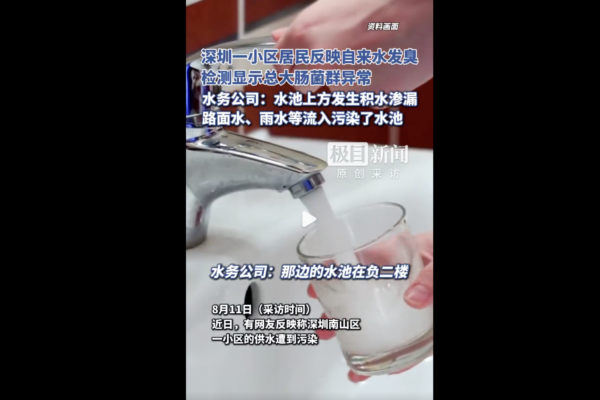Recently, residents in a community in Nanshan District, Shenzhen, Guangdong Province, have reported that the tap water has a foul smell. Test results showed that the water exceeded the limits for total coliform bacteria and E. coli, with initial assessments suggesting that the contamination was due to sewage leakage at the secondary water supply pump room. This incident marks the second water quality issue in about a month in Shenzhen, a first-tier city in China, causing strong public concerns.
According to netizens, the water supply in a community in Nanshan District, Shenzhen, was found to be contaminated. In early August, some residents in the community reported a foul smell in the water. The relevant department sampled the water in the secondary pump room, and test results showed that the total bacterial count, total coliform bacteria, and E. coli were all found to be unsatisfactory. Preliminary investigations revealed that the reason for the unsatisfactory indicators in the water samples was the seepage of water accumulated in the collection pit on the negative first floor into the water tank in the secondary pump room.
The netizen mentioned that the incident occurred in the Yuehai Street neighborhood, and updates will be provided on the forum. Images in the post showed that the limits for total coliform bacteria and E. coli were “non-detectable,” yet both test results were unsatisfactory.
According to a report by Jumuk News, a staff member of the Nanshan District Water Affairs Bureau mentioned that specific inquiries could be directed to the Water Affairs Company.
On August 11th, as a resident, a journalist from the media consulted the local Water Affairs Company, and the staff confirmed the aforementioned information, stating that the test results of the water tank storage indeed showed unsatisfactory levels of total coliform bacteria and E. coli. The staff member also mentioned, “Due to the impact of heavy rain, water seepage from the road surface and rainwater flowing into the water tank contaminated the water.”
Despite the repeated claims by the local Water Affairs Company staff that “there are no issues with the residents’ current water supply,” this statement did not alleviate the residents’ concerns.
Many netizens expressed that the high levels of coliform bacteria in the water were a clear indication of fecal contamination, posing a direct threat to the health of vulnerable groups such as the elderly and children, even if it may not immediately lead to illness.
A Shenzhen netizen, under the username “Zhou Gong Dreaming,” commented that in the days following the incident, the street community’s water service organization held a meeting to report the situation to property owners. Residents expressed dissatisfaction with the property management company for their perceived lack of responsibility and suggested the need for a change in property management.
Netizens believed that this incident exposed negligence in the management of the “secondary water” system (a system that pressurizes and stores water from the main water supply before transporting it to high-rise residents). Residents pay management fees to the property management expecting safety guarantees, yet the water quality issue was only discovered after residents reported the water smelling foul. This not only raised strong doubts about the property management among residents but also eroded their trust in the local water authorities’ regulatory capabilities.
This is the second recent water quality issue in Shenzhen. In July, Southern Metropolis Daily reported that several Shenzhen residents posted on the People’s Network message board complaining about tap water being “heavily scaled” and having an unpleasant taste, hoping for residents to have access to safe drinking water.
Netizens from different areas in Shenzhen expressed their concerns:
“Angel of Light-Zhang Wuji”: In Guangming District, Shenzhen, water scaling is extremely severe, and after boiling water, a shiny substance floats on the surface.
“Chirping Baby”: Using a transparent kettle for water, there are many white floating powders.
“Stars Beneath the Bright Moon”: In my home, a transparent glass thermos, after boiling and cooling, always has pellet-like particles at the bottom!
“8-Minute Caron”: The water in Bao’an is much worse than before, all full of water scaling. The kettle used to have no scaling for so many years, but now after boiling once, there is white sediment.
“Listening to the Rain in the Bamboo Forest”: As an advanced city at the forefront of technology like Shenzhen, when will every home be able to install direct drinking water systems?

